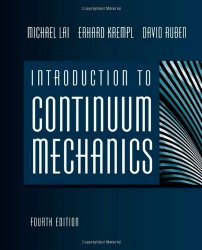Engineering Bookshelf
- Aerospace
- Biological
- Civil
- Chemical
- Environmental
- Electrical
- Materials
- Mechanical
- Petroleum
- Geoengineering
- Software

Introduction to Continuum Mechanics
by W Michael Lai, David Rubin, Erhard KremplPublisher: Elsevier
ISBN: 0750685603
Check price @ amazon.com , amazon.ca , amazon.co.uk
Book Description
Continuum Mechanics is a branch of physical mechanics that describes the macroscopic mechanical behavior of solid or fluid materials considered to be continuously distributed. It is fundamental to the fields of civil, mechanical, chemical and bioengineering.
This time-tested text has been used for over 35 years to introduce junior and senior-level undergraduate engineering students, as well as graduate students, to the basic principles of continuum mechanics and their applications to real engineering problems. The text begins with a detailed presentation of the coordinate invariant quantity, the tensor, introduced as a linear transformation. This is then followed by the formulation of the kinematics of deformation, large as well as very small, the description of stresses and the basic laws of continuum mechanics. As applications of these laws, the behaviors of certain material idealizations (models) including the elastic, viscous and viscoelastic materials, are presented.
This new edition offers expanded coverage of the subject matter both in terms of details and contents, providing greater flexibility for either a one or two-semester course in either continuum mechanics or elasticity. Although this current edition has expanded the coverage of the subject matter, it nevertheless uses the same approach as that in the earlier editions - that one can cover advanced topics in an elementary way that go from simple to complex, using a wealth of illustrative examples and problems. It is, and will remain, one of the most accessible textbooks on this challenging engineering subject.
- Significantly expanded coverage of elasticity in Chapter 5, including solutions of some 3-D problems based on the fundamental potential functions approach.
- New section at the end of Chapter 4 devoted to the integral formulation of the field equations
- Seven new appendices appear at the end of the relevant chapters to help make each chapter more self-contained
- Expanded and improved problem sets providing both intellectual challenges and engineering applications
About the Author
Professor of Mechanical Engineering and Orthopaedic Bioengineering at Columbia University, New York
Customer Reviews
By Patrick J. McDaniel
This is the best text I have been able to find for the course I am teaching at the first year graduate level in Continuum Mechanics. the authors explain the material in excellent detail without a lot of obscure notation and an over emphasis on tensor analysis. I would have given them 5 stars if there weren't still a few typos in a few of the equations. that always scares me because I do not want to derive the equations every time I use them.
By F. YAN
After looking over a dozen of books on this topic, I have settled down on this one and almost finished it. It is easy for self-study with bounty of examples to help you further understand and master the abstract concepts. I can't believe the guy's attack on this book saying that this book is an insult for experts. What is your name, are you Albert Eistein?
By P. Lucht
Knowing nothing about continuum mechanics, I read this entire book in 2012 and found it to be excellent. For sure, the math is non-trivial, but is pretty much all derived in Chapter 2, a sort of tensor boot-camp for would-be readers, where things are done in Cartesian, spherical and cylindrical coordinates. Admittedly I already knew much of this stuff, but not all of it. The book is populated with many nuts and bolts examples which bring esoteric concepts down to earth. The examples are rather sly in that seemingly obscure results of earlier examples are applied in later examples, sometimes far down the road. There are also many problems for the reader to solve, though I confess I did only a few. The text develops the general theory of dealing with "particles of continuous matter" (solid or fluid). Chapter 3 treats strain, then Chapter 4 does stress. Up to this point things are general, but then Chapter 5 applies the theory to elastic solids, providing a mini-textbook on this subject, beams and torsion and all that good stuff. Some material on anisotropic solids and large deformations is included at the close. Chapter 6 then changes the focus from solids to Newtonian viscous fluids (like water and air) and the non-linear Navier-Stokes equations are derived. The whole subject of boundary layers and Reynolds numbers and the lift of airplane wings is pretty much skipped over, the reader must find other books on these traditional subjects. I was a bit disappointed, but the book after all is an "introduction". No Magnus Effect for curving baseballs and top-spinning tennis balls. Instead, in Chapter 7 the reader gets a nice treatment of the Reynolds Transport Theorem which shows how to replace time derivatives of material-volume integrals with control-volume integrals.